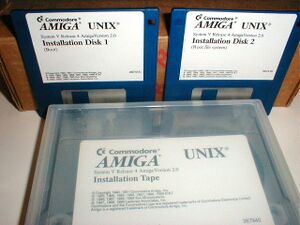Software:Amiga Unix
 | |
| Developer | Commodore-Amiga, Inc. |
|---|---|
| OS family | Unix (SVR4) |
| Working state | Historic |
| Source model | primarily closed source |
| Initial release | 1990[1] |
| |Final release|Latest release}} | 2.01[2] / 1992 |
| Platforms | Motorola 68030 |
| Kernel type | Monolithic |
| License | Proprietary |
Amiga Unix (informally known as Amix) is a discontinued full port of AT&T Unix System V Release 4 operating system developed by Commodore-Amiga, Inc. in 1990 for the Amiga computer family as an alternative to AmigaOS, which shipped by default.
Overview
Bundled with the Amiga 2500UX and Amiga 3000UX, Commodore's Unix was one of the first ports of SVR4 to the 68k architecture. The Amiga A3000UX model even got the attention of Sun Microsystems, though ultimately nothing came of it.[3]
Unlike Apple's A/UX compatibility layer for System 7 applications, Amiga Unix contains no compatibility layer for AmigaOS applications. With few native applications available to take advantage of the Amiga's significant multimedia capabilities, it failed to find a niche in the competitive Unix workstation market of the early 1990s. The A3000UX's price of US$4,998 (equivalent to $11,500 in 2024)[4] was also not very attractive compared to other Unix workstations at the time, such as the NeXTstation ($5,000 for a base system, with a full API and many times the number of applications available), the SGI Indigo (starting at $8,000), or the Personal DECstation 5000 Model 25 (starting at $5,000). Sun, HP, and IBM had similarly priced systems. The A3000UX's 68030 was noticeably underpowered compared to most of its RISC-based competitors.[5][6]
Unlike typical commercial Unix distributions of the time, Amiga Unix included the source code to the vendor-specific enhancements and platform-dependent device drivers (essentially any part that wasn't owned by AT&T), allowing interested users to study or enhance those parts of the system. However this source code was subject to the same license terms as the binary part of the system – it was not free software. Amiga Unix also incorporated and depended upon many open source components, such as the GNU C Compiler and X Window System, and included their source code.
Like many other proprietary Unix variants with small market shares, Amiga Unix vanished into the mists of computer history when its vendor, Commodore, went out of business. Today, Unix-like operating systems such as Minix, NetBSD, and Linux are available for the Amiga platform.
See also
- Atari TT030, Unix workstation from Atari
References
- ↑ Short Takes: A Unix graphics workstation for the rest of the world, By Ben Smith, Page 134 & 136, Byte Magazine Volume 15 Number 13
- ↑ A3000UX - Commodore, ...it was shipped with an alternative UNIX operating system called Commodore Amiga UNIX, affectionately known as Amix. Amix was a full port of AT&T's System V SVR4 UNIX and included the X Window System which is a server for hosting graphical environments and the Open Look graphical interface...Shortly after release, Sun Microsystems, a major UNIX vendor was interested in rebadging the A3000UX for supplying as an entry level UNIX workstation. Unfortunately in true Commodore style, the deal fell through. Commodore also released another UNIX based workstation called the A2500UX.
- ↑ Commodore: A3500
- ↑ "Commodore Amiga 3000UX bundle". http://www.amigahistory.plus.com/a3000ux.html.
- ↑ DigiBarn Systems: SGI Silicon Graphics Indy
- ↑ Burgard, Mike (December 1991). "More than a Toy but No Bargain". UnixWorld. http://docs.unix-history.com/reviews/amiga3000ux.pdf. Retrieved 2007-12-18.
External links
- Manual: Commodore, Amiga Unix, System V Release 4, Learning Amiga Unix (11/1990)
- The Very Unofficial Commodore Amiga Unix (AMIX) Wiki
- Video of AMIX running under FS-UAE
 |
